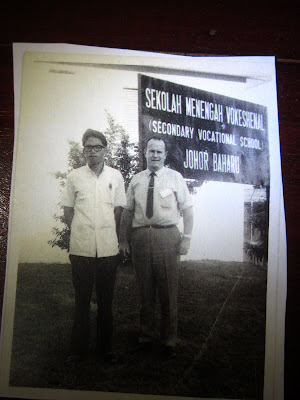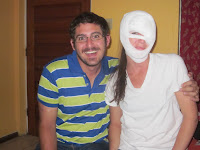(My father's sister's daughter)
Returned Peace Corps Volunteer
Ambato, Ecuador
Special Education Program 1984-1986
Rory, Linda, and Audrey
Service: In Linda's Words
A few years before I went to Ecuador, Peace Corps had started a Special Education program in rural areas in Ecuador, but it apparently didn't go well for one thing, in sparsely populated areas there weren't very many students with disabilities to serve. Another thing, they apparently found, was that handicapped people in rural Ecuador in the 80s were doing just fine. They could serve their communities and families by working the land, working with the animals, helping on the farms
So, the volunteers in my program all worked in cities where there were schools and students who could benefit from newly developed programs. My main project was to develop classrooms for students with learning disabilities in public schools. I lived with two other special ed volunteers and we always were involved in each other's projects, so what I did there went further than just my own work. One of my roomates was establishing a special education resource library at the special education school in Ambato. I would often hang out in her library helping her catalog, write grants, translate materials, etc. The other roomate was first a business volunteer, and did an extension project at the special ed school. He started an agriculture program, a small garden and small animals ("food" animals in Ecuador). Besides growing vegetables and raising chickens and rabbits, they also went to the market every Monday to sell their products, so that's where the whole business end of it came in. We also all three together taught a sign language class to teachers and parents. Which was really fun. Not one of us was fluent in sign language or had any formal training in it, but, there was a volunteer in Ecuador who was deaf and because of our friendship with him, we all became quite adept at signing.

Cousin Linda on the left at the National Handicap Awareness Day opening event (actually a 2 day event)
My favorite project was one that the three of us, along with many Ecuadorean teachers and many other Special Ed. volunteers from around the country worked on together. We held a National Handicap Awareness Day (actually 2 days) in Ambato, in the public park. The Coca Cola Company lent us kiosks (and delivered them, put them together, took them down, and hauled them away). We had a kiosk for a each of a number of different "handicapping conditions". Each kiosk was manned by Ecuadorean professionals who worked in that field. We had tons of information on hand about the condition itself, where and how to find services, etc. We also had many "awareness" activities going on throughout the weekend. You could nagivate an obstacle course wearing special vision impaired or blind eyewear, try to get around the park in a wheelchair, take a "dislexia" test, walk around "deaf". We even had a wheelchair basketball games. There was a real wheelchair basketball organization....one of their teams came down from Quito and challenged non-wheelchair users to wheelchair basketball. It was great fun to watch and everyone was a good sport. One of our greatest accomplishments from this event was that the very first ever wheelchair access ramp in Ecuador was installed in the municipal building in Ambato and unveiled at this event. It was a huge catalyst for the spread of accessibility throughout Ecuador. One of the funniest things is.....I have to preface this a bit first.....this project took place about halfway through my second year there. At that time I was very comfortable in Ecuador and with speaking Spanish. I was full of confidence and believed that I just blended in with the natives, spoke like a native, etc. Well, Xavier video-taped me making opening remarks for the kick off of this awareness weekend in a public park in Ecuador, with the mayor there, the media, tons and tons of people. We watched that video at the end of the day and I was mortified!! I spoke Spanish like a gringa! HUGE American accent! It was a shocking eye-opener for me and very humbling!

One of her classes at Liceo Cevallos
Communication in the 80's:
When I was in Ecuador there was no email, there were no cell phones, we didn't even have a land-line in our house. I wrote letters to my family and friends and they to me. But, mail delivery in Ecuador was shady and sometimes I didn't ever get what was mailed to me. To call home I had to go stand in line at the phone company....pick a number, wait for my number to be called, wait for the employee to dial the number, hope it would go through, the connection was always horrible, it cost a ton of money. And it wasn't really all that long ago....okay, it was 25 years ago, but still! As I was writing the Handicap Awareness Day stuff above I was wondering, trying to remember how we got ahold of all those people and got them together. We managed somehow, obviously!
Cousin Linda's roommates Lisa and Parmer
Volunteers hanging out at the training center
Ecuadorian PCV's 1984-1986:
I entered Ecuador as one of a group of 48 volunteers. There were only 26 of us at the Close of Service Ceremony. Of the 22 who didn't finish most returned to the states for health reasons, either their own or a family member. A few (three if I remember) were kicked out for breaking some rule or other (for example...one guy was kicked out because he had been caught driving a motorcycle without a helmet right when the leadership was having this huge helmet safety thing. (They made an example out of him, which was too bad). An older woman was really struggling with learning Spanish and so, was transfered to somewhere where she wouldn't need to learn Spanish. The most heartbreaking was the death of a good friend of mine, Audrey Copeland. She drowned in a river in the jungle the day before Easter of our first year of service. There is a photo of her above.
Life After Peace Corps:
I am married to an Ecuadorean man I met while in the Peace Corps, Xavier Gonzalez. We got married in Ecuador right after my COS (Close of Service). We went to Cleveland for about 8 months or so and then returned to Ecuador for 2 more years, went back to Cleveland after that for 4 years or so and have been out here in Woodinville since 1994. Xavier is a doctor and works in medical research (cardiology and pulmonary research). I am a teacher. I do tutoring with at risk youth and tons of volunteer work.
Our oldest son, Gary, was born in Ecuador and though we left when he was just 5 weeks old, he's very proud of his Ecuadorean birth. The Peace Corps has had a huge influence on everything in my life. I have always sought work that serves a bigger purpose than just a paycheck. I do a lot of volunteer work and advocacy with immigrant populations in Woodinville, mostly through the schools. I stay involved with the Return Peace Corps Volunteer organizations, the one in Cleveland when we were there and the one here in Seattle. We travel back to Ecuador often because we have family there. My children speak Spanish, love to travel, and have a keen sense of community development. They've been involved in projects such as gathering and donating soccer gear to underpriveleged kids in Ecuador, holding after school soccer camps here with low income students, etc. I really want to join the Peace Corps again. Xavier and I plan to sign up once the boys get out of college and are on their own.
Thanks so much Cousin Linda for taking the time to share your story and dig up some photos! I hope you all enjoy a little peep into Peace Corps past!
Did you know that?
I was born the same year Cousin Linda entered the Peace Corps
She was serving during the 25th anniversary of Peace Corps and I am serving during the 50th!
AND the anniversaries were both during our second year of service!
Now you know!
*bonus points if you got the reference to Bill Nye the Science Guy*























